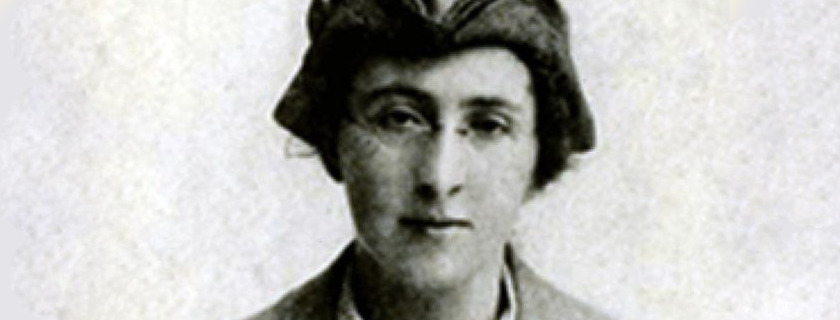Margaret Skinnider
Rebel of 1916
Margaret Skinnider was born in Scotland around 1893. Her mother was Scottish and her father was originally from Co. Monaghan. She trained as a teacher in Glasgow and taught mathematics there until 1916, when she resigned to take part in the Easter Rising in Dublin. She also worked in the campaign for women’s suffrage and was a member of the Women’s Social and Political Union in Scotland. During the War for Irish Independence (1916-1923) Skinnider became an active member of Cummann na mBan, the women’s auxiliary to the Irish Republican Army and in 1922 was made Paymaster General for the IRA. Skinnider joined a rifle practice club in Scotland where women could learn to shoot in defence of the British Empire. “I kept on till I was a good marksman”, she wrote in her autobiography, “I believed the opportunity would soon come to defend my own country”.
Margaret Skinnider went to Dublin at Christmas 1915 at the invitation of Constance Markievicz. On this trip by boat she carried detonators for bombs in her hat and wires wrapped around her body under her coat. She stayed on deck so as not to detonate the bombs accidentally, perhaps on a hot water pipe or an electric wire, which might set them off. During this trip Markievicz asked Skinnider to make a plan of the Beggar’s Bush barracks. She first scrutinised a large map of Dublin and then found her way to the barracks and surveyed them from every angle. She crossed the street to get a better look over the wall of the barracks and discovered a building which, she concluded, held a powder magazine. Lisa Wiehman, in her article on Skinnider, claims that she used her gender to shield herself from suspicion, tricking a young boy into aiding her to create a map of the barracks. She pretended to lose her handkerchief and the young boy offered to retrieve it while she stood on tip toe and assessed that it would be possible to dig a tunnel between two walls and place explosives and a detonator in this hole. The plan was written down and shown to James Connolly, who agreed that it could be carried out if conscription was introduced in Ireland. From that day forward Skinnider was taken into the confidence of the Republican leader.
Skinnider returned to Dublin on Holy Thursday 1916 having joined the Citizen Army. She was involved in taking ammunition from hiding places and bringing it to Liberty Hall, and served as a despatch rider for Michael Mallin at St. Stephen’s Green. At one stage during the fighting she was sent to Leeson St. Bridge to bring 16 men back to Stephen’s Green. They rendezvoused at the College of Surgeons. Skinnider became a sniper under the roof. She changed into army uniform and observed from her post the British soldiers on the roof of the Shelbourne Hotel. “More than once I saw the man I aimed at fall”. She was sent out with four men under her command to set fire to a building to cut off the retreat of a British force which had planted a machine gun on the flat roof of University Church. In her book, Ruth Taillon quotes James Connolly’s daughter Nora, who described this incident as an example of the relationship that existed between women and men in the Citizen Army. “When they were going out to attack a nest of snipers she was in charge of the squad”.
Skinnider was shot three times and lay in agony in the college for three days while the fighting continued. She never saw Commandant Mallin again because he was executed by the British. Skinnider spent seven weeks in hospital and was incredulous that the leaders of the rising were executed. “We had obeyed all rules of war and surrendered as formally as any army ever capitulated”. She sailed for America on 11 December 1916 and spent the years 1917-1918 on a propaganda tour for Cummann na mBan. On her return to Ireland she trained Volunteer recruits and was active through the War of Independence. Skinnider was imprisoned in Mountjoy jail and the North Dublin Union (1922-1923) and received no pension from the government, because she was a woman.
In 1923 Skinnider became a teacher in King’s Inn Street Dublin and in 1949 a member of the executive of the INTO, where she is particularly remembered for her efforts in the fight for the rights of its women members. She became President of the INTO in 1956 and served on the Irish Congress of Trade Unions executive council until 1963. Margaret Skinnider died in October 1971 and is buried in the Republican Plot beside Countess Markievicz in Glasnevin Cemetery.
Maggie Power
Bibliography
Sara Alpern, Joyce Antler, Elizabeth Israels Perry, Ingrid Scobie (eds.), The Challenge of Feminist Biography Writing the Lives of Modern American Women, University of Illinois Press, 1992
Lawrence William White, ‘Skinnider, Margaret (Ni Scineadora Maighread)’, Dictionary of Irish Biography, James McGuire, James Quinn (eds.), Cambridge University Press.
Margaret Skinnider, Doing My Bit For Ireland, 1917, The Century Co., New York, 1917
Ruth Taillon, When History Was Made: The Women of 1916, Beyond the Pale Publications, 1996
Lisa Weihman, 2004 http://muse.jhu.edu/journals/eire-ireland/v039/39.3weihman.htlm

